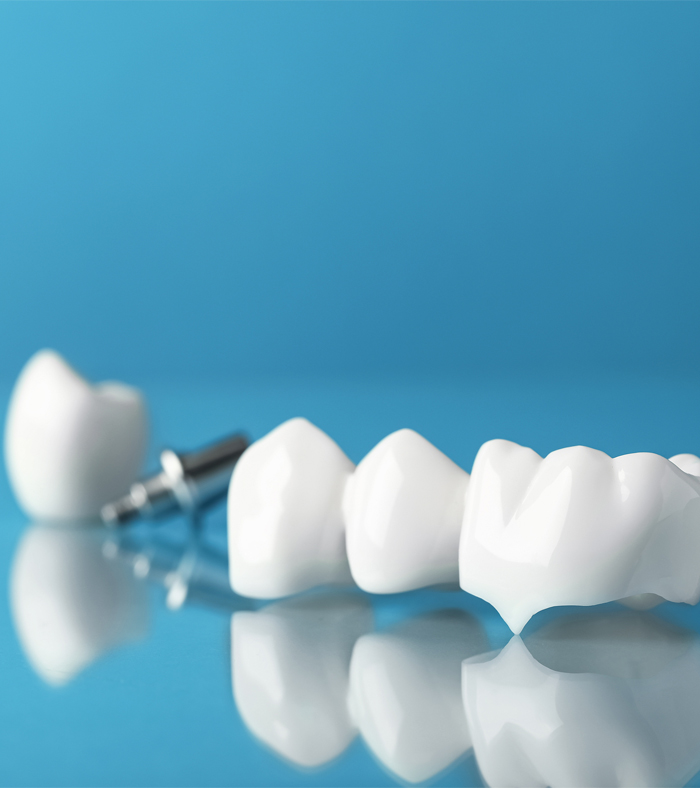
Prosthodontist in Burtonsville Dental Suite
The planning and commissioning of a complete smile makeover may necessitate a team of several dental professionals. More often than not, that team is headed by a prosthodontist. A prosthodontist focuses primarily on the restoration and replacement of missing or damaged teeth and creating functional, natural-looking smiles for patients.
A prosthodontist is available at Burtonsville Dental Suite in Burtonsville and the surrounding area. Though much of what we do involves repairing and replacing teeth with a variety of removable or fixed prosthetic options, our team also corrects issues stemming from the lips, gums, and facial features. Ultimately, we strive to restore or preserve dental function, appearance, and health through proper diagnosis, treatment planning, restoration, and maintenance.
Whether you want to improve comfort and functionality, desire a more attractive smile, or both, a prosthodontist is the professional for you. Our entire staff stands ready to answer your questions and address any concerns. Call (301) 421-1300 to schedule a consultation with Burtonsville Dental Suite and the team today.
How Prosthodontist Differ From General Dentists
Prosthodontists are recognized as the go-to professionals for replacing anything in the mouth. While various types of dentists have some training in restorative dentistry, prosthodontists have years of additional education.
Upon completing dental school, prosthodontists must receive an extra three years of advanced training through a graduate program accredited by the American Dental Association. To ensure their skillsets match their knowledge, aspiring prosthodontists combine their specialized education with hours of clinical experience.
“To ensure their skillsets match their knowledge, aspiring prosthodontists combine their specialized education with hours of clinical experience.”
Board-Certified Prosthodontists
Many prosthodontists choose to seek board certification to set them even further apart from other dental professionals. This designation demonstrates a commitment to lifelong learning and ethical practices. Board certification also shows that the professional values the patient-doctor relationship and is devoted to advancing restorative dentistry.
To obtain board certification, a prosthodontist must successfully pass the American Board of Prosthodontics' four-part examination. The ABP requires certified professionals to undergo the recertification process every eight years to ensure they are current on best restorative practices.
“Many prosthodontists choose to seek board certification to set them even further apart from other dental professionals.”
Why Prosthodontics
- Cleft palates or missing teeth
- Complete and removable partial dentures
- Complex care management
- Cosmetic dentistry
- Dental implants
- Oral cancer reconstruction
- Snoring and sleep disorders
- Temporomandibular joint syndrome/disorder
- Tooth replacement
- Traumatic facial injuries
“Prosthodontists have advanced training and utilize the most current restoration technology and techniques.”
“Prosthodontists have advanced training and utilize the most current restoration technology and techniques.”
Areas of Prosthodontic Treatment
- Crowns: Patients may need crowns if they recently underwent a root canal or have fractured, misshapen or broken teeth. Crowns cover the entire visible surface of a tooth above the gum line. They are sometimes also known as caps.
- Porcelain Veneers: Veneers are ultra-thin casings of ceramic that cover the front of the tooth. Veneers reshape, elongate, or change the color of teeth. Occasionally they are implemented to close small gaps.
- Dental Implants: Implants are necessary to replace missing or severely damaged teeth. Implants consist of titanium steel posts that the dentist embeds into the gum line via a surgical procedure. These posts fuse to the jawbone and provide unwavering support for the cap, designed to look and feel like a natural tooth.
- Dentures: Full and partial dentures help improve the aesthetics and functionality of a person who is missing several teeth. Implant-supported dentures provide additional stability. They are attached to the implants rather than resting on the gums.
- Fixed Bridges: This method involves using a natural tooth on either side of a gap to support a bridge of one or more artificial teeth. The placement of a bridge usually takes several dental visits. Bridges may last for 10 to 15 years.
“All prosthodontic patients undergo an extensive examination and consultation before receiving treatment.”
Finding a Local Prosthodontist
Luckily, finding a local prosthodontist is now easier than ever. Online review sites, such as Healthgrades, are a popular starting place for many potential patients when looking for a new prosthodontist. These allow individuals to compare and contrast potential providers. Patients can also turn to a practice's social media practice to determine if a doctor may be a good fit for them.
More traditional patients can also rely on word-of-mouth referrals from their friends, family members, or doctors. Regardless of whatever method an individual chooses, everyone should begin their search knowing what they are looking for: Do they want a prosthodontist that is nearby for optimal convenience? Are they looking for someone who treats all ages so that they can take the whole family? These questions can help guide one's search.

